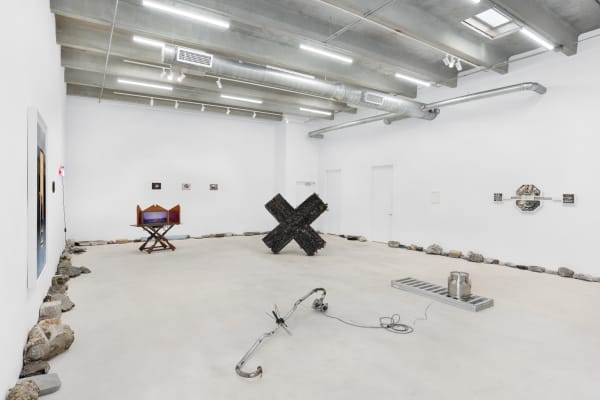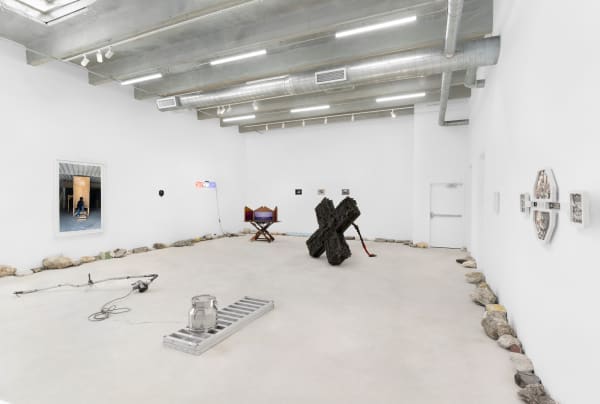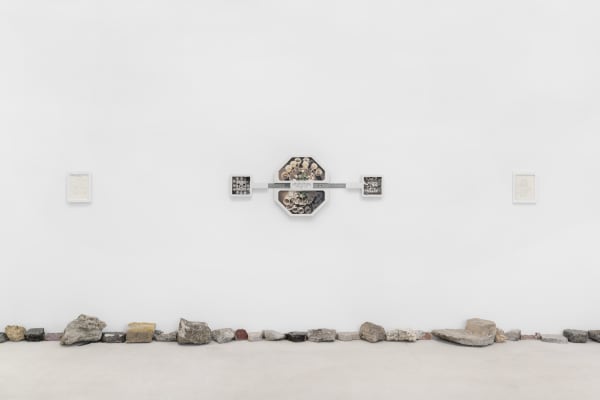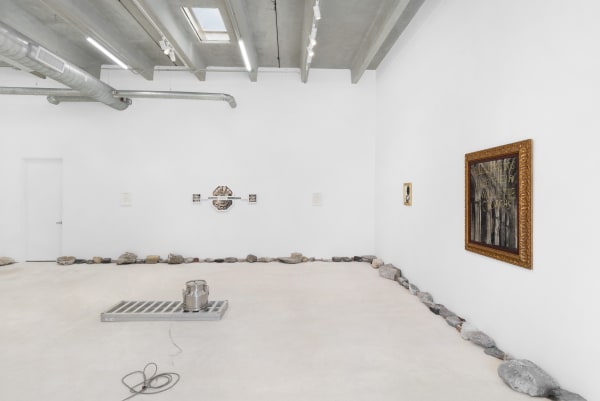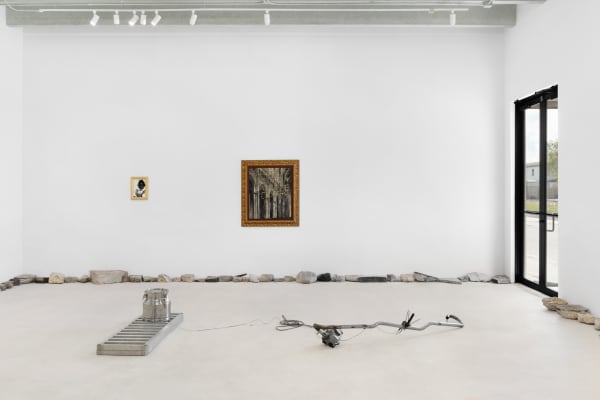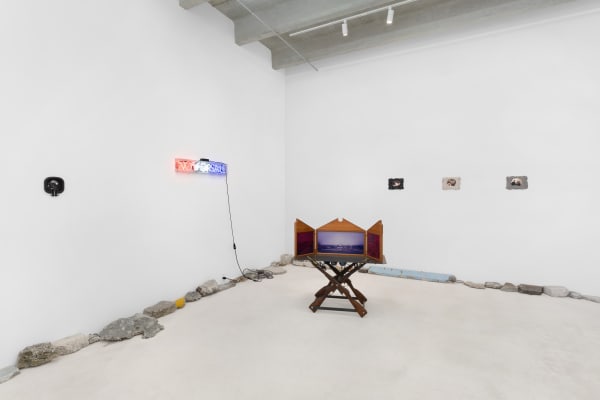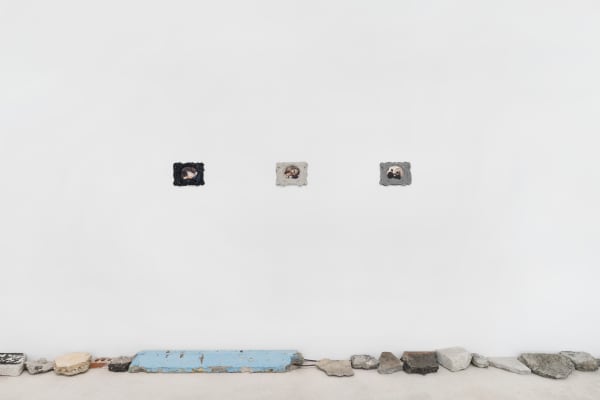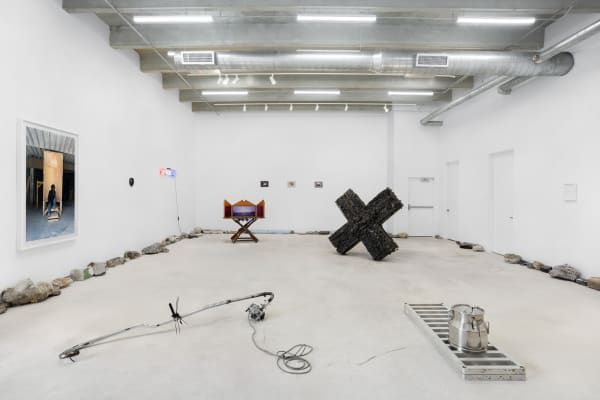Moving the Mortared Line
Voloshyn Gallery is pleased to present Moving the Mortared Line, a group exhibition curated by Catherine Mary Camargo, featuring works by David Correa, Alberto Checa, Tom Scicluna, Christopher Carter, Javier Barrera, George Sanchez-Calderon, Luna Palazzolo-Daboul, and Loni Johnson.
Moving the Mortared Line brings together a group of artists whose practices are grounded in the use of materials and tools born out of necessity—those often found in construction, repair, or survival. The exhibition takes its title from the labor material mortar, used both literally and metaphorically to signal acts of building, binding, and resisting within precarious conditions. Plaster, wood, steel, propane gas, a repurposed weed eater handle, iron bolts, cement, and stills from baptism footage—these are just a few of the materials activated across the included works. Each artist engages with the friction between the man-made and the lived, tracing personal and political histories embedded in everyday objects and gestures.
The exhibition embraces intentional, often humble materials—those overused, quickly discarded, or rarely afforded artistic value. These politically charged objects challenge dominant ideas of worth, class, and taste within the art world. The thin line between taste and prosperity—especially as defined through the eyes of the wealthy—is disrupted as everyday objects become charged with energy, memory, and resistance. Moving the Mortared Line asks us to consider how material can carry its own currency: one imbued with experience.
While some of the artists in Moving the Mortared Line actively engage with generative systems and algorithmic data—translating structure into visual form as a critique of capitalist excess, social bias, and cultural invisibility—others approach these concerns more subconsciously, drawn intuitively to materials and forms that echo similar tensions and ideas. David Correa, for instance, uses performance, poetic narrative, and relic-like sculpture to satirize modern man’s existential entanglement with machines and tools. Alberto Checa repositions the labor of the brown body by working with improvised, utilitarian materials—his sculptural systems reveal the futility and hidden loops of capitalist production. Loni Johnson, through ritual and movement, creates spaces of healing and reflection for Black women, drawing on ancestral memory and embodied knowledge in her multidisciplinary installations, performances, and inclusive workshops. Meanwhile, Christopher Carter assembles large-scale sculptures from found industrial materials, honoring the layered complexity of his African American, Native American, and European heritage. Overall, symbolic signs and easily digestible references begin to lose meaning in their individual practices, Moving the Mortared Line evokes a return to simple objects and direct gestures—traces of the body, behavior, labor, nature, and spatial exploration are restored.
This ethos inherently draws inspiration from the conceptual art movements of the 1960s, such as Arte Povera in Italy and Mono-ha in Japan, whose artists utilized common objects and ephemeral materials. It also engages with the concept of “Architecture of Necessity,” introduced by Cuban artist and theorist Ernesto Oroza, which examines the built spaces and everyday objects made or repaired for daily use in Cuba.
The work highlights a recurring human impulse: in conditions of scarcity, people instinctively turn to the debris around them—weathered chairs, car parts, fragments of the urban landscape—reshaping them through necessity. Perception narrows to sheer utility, and a quiet choreography of improvisation takes hold. What may seem like a response to lack or contamination becomes an intuitive practice of making with what’s at hand. As Ernesto Oroza writes, “The individual in need will focus exclusively on the repertoire of the usefulness, propitiating a conjunction, a harvest time”1—a moment when disparate materials converge through urgent utility and improvisation.
Significantly, the improvisational objects documented by Oroza resonate with the character of 1960s conceptual art movements such as Arte Povera. Curated by Germano Celant, Arte Povera challenged capitalist spectacle by embracing humble, everyday materials such as—twigs, burlap, stone—as a form of political resistance and poetic critique. Artists like Jannis Kounellis, Pier Paolo Calzolari, and Luciano Fabro revealed how scarcity could become creative strategy. Yet a central critique of Arte Povera lies in the inconsistency of this logic among its artists: Fabro, for instance, often used marble—a material far from ephemeral or “poor.” His work opened a conversation with classical traditions and the legacy of Italian art, from the Roman Empire to the Renaissance, complicating the movement’s anti-establishment framing.
This exhibition builds upon such histories while extending them into a wider, often overlooked global context of material use. Rather than draw only from canonized examples, it centers the resourceful practices that have long existed in Afro-diasporic, Caribbean, Latin American, and Afro-Arab regions—contexts where scarcity and survival give rise to sophisticated systems of making, deeply embedded in local cultural life. These gestures, while resonant with conceptualism, are rarely archived within dominant narratives of art history. The question, then, is not whether the work shares formal affinities with Arte Povera or Mono-ha, but why similar gestures in different geographies have been historically excluded from the same recognition. The often crucial distinction: in places like the Caribbean, where economic necessity and limited access to materials define daily life, DIY engineering and innovation aren’t artistic choices—they are vital strategies for survival. Function comes before aesthetics.
These sensibilities resonate with the artists in Moving the Mortared Line, many of whom blur the boundary between minimalism and resistance. Though born in places like London, Cuba, Argentina, and Miami, all eight artists have lived and worked within Miami’s layered social fabric. Their chosen materials and explored narratives—whether consciously or not—reflect lived experiences shaped by a city where legally documented immigrants comprised 65% of the labor force as of 2019, profoundly influencing its cultural, social, and economic landscape. Therefore, their works often reflect the lived realities of systemic imbalance, especially as experienced by working-class individuals and underrepresented communities.
Ultimately, Moving the Mortared Line traces a loose but deliberate cartography of global precarity and resistance. It seeks to draw lines—sometimes faint, sometimes insistent—between geographies, class conditions, and inventive material practices. The exhibition remains anchored in my own position as a half-Haitian, half-British artist and researcher from Miami, shaped by a multicultural lens and a deep sensitivity to what is often left unsaid or undervalued. These works treat material not only as medium but as evidence—of survival, of critique, and of care. They remind us that in contexts of constraint, making becomes not only an act of resistance, but also a blueprint for community and expanded definitions of taste and aesthetic value.
Words from the Curator,
Catherine Mary Camargo
1 “The individual in need will focus exclusively on the repertoire of the usefulness, propitiating a conjunction, a harvest time.”
Ernesto Oroza, Updating City (theorem) – 2000/2010. Accessed May 28, 2025. https://www.ernestooroza.com/updating-city-theorem-20002010/.
Opening Reception: Friday, June 6th, 6:00 PM to 8:00 PM
Dates: June 6th - July 20th, 2025
Gallery Hours: Tuesday–Saturday, 11:00 AM to 5:00 PM
Address: 802 NW 22nd Street, Miami, FL, US, 33127


